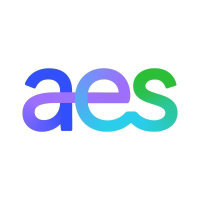
AES Corp
NYSE:AES


| US |

|
Johnson & Johnson
NYSE:JNJ
|
Pharmaceuticals
|
| US |

|
Berkshire Hathaway Inc
NYSE:BRK.A
|
Financial Services
|
| US |

|
Bank of America Corp
NYSE:BAC
|
Banking
|
| US |

|
Mastercard Inc
NYSE:MA
|
Technology
|
| US |

|
UnitedHealth Group Inc
NYSE:UNH
|
Health Care
|
| US |

|
Exxon Mobil Corp
NYSE:XOM
|
Energy
|
| US |

|
Pfizer Inc
NYSE:PFE
|
Pharmaceuticals
|
| US |

|
Palantir Technologies Inc
NYSE:PLTR
|
Technology
|
| US |

|
Nike Inc
NYSE:NKE
|
Textiles, Apparel & Luxury Goods
|
| US |

|
Visa Inc
NYSE:V
|
Technology
|
| CN |

|
Alibaba Group Holding Ltd
NYSE:BABA
|
Retail
|
| US |

|
3M Co
NYSE:MMM
|
Industrial Conglomerates
|
| US |

|
JPMorgan Chase & Co
NYSE:JPM
|
Banking
|
| US |

|
Coca-Cola Co
NYSE:KO
|
Beverages
|
| US |

|
Walmart Inc
NYSE:WMT
|
Retail
|
| US |

|
Verizon Communications Inc
NYSE:VZ
|
Telecommunication
|
Utilize notes to systematically review your investment decisions. By reflecting on past outcomes, you can discern effective strategies and identify those that underperformed. This continuous feedback loop enables you to adapt and refine your approach, optimizing for future success.
Each note serves as a learning point, offering insights into your decision-making processes. Over time, you'll accumulate a personalized database of knowledge, enhancing your ability to make informed decisions quickly and effectively.
With a comprehensive record of your investment history at your fingertips, you can compare current opportunities against past experiences. This not only bolsters your confidence but also ensures that each decision is grounded in a well-documented rationale.
Do you really want to delete this note?
This action cannot be undone.

| 52 Week Range |
12.44
21.77
|
| Price Target |
|
We'll email you a reminder when the closing price reaches USD.
Choose the stock you wish to monitor with a price alert.

|
Johnson & Johnson
NYSE:JNJ
|
US |

|
Berkshire Hathaway Inc
NYSE:BRK.A
|
US |

|
Bank of America Corp
NYSE:BAC
|
US |

|
Mastercard Inc
NYSE:MA
|
US |

|
UnitedHealth Group Inc
NYSE:UNH
|
US |

|
Exxon Mobil Corp
NYSE:XOM
|
US |

|
Pfizer Inc
NYSE:PFE
|
US |

|
Palantir Technologies Inc
NYSE:PLTR
|
US |

|
Nike Inc
NYSE:NKE
|
US |

|
Visa Inc
NYSE:V
|
US |

|
Alibaba Group Holding Ltd
NYSE:BABA
|
CN |

|
3M Co
NYSE:MMM
|
US |

|
JPMorgan Chase & Co
NYSE:JPM
|
US |

|
Coca-Cola Co
NYSE:KO
|
US |

|
Walmart Inc
NYSE:WMT
|
US |

|
Verizon Communications Inc
NYSE:VZ
|
US |
This alert will be permanently deleted.
 AES Corp
AES Corp
AES Corp
Investor Relations
AES Corporation, founded in 1981, has journeyed from a modest start-up to a global leader in the energy sector. Originating with a vision to provide reliable electricity, AES has consistently innovated to meet the evolving needs of the energy market. The company operates in over 15 countries, with its portfolio spanning various continents, delivering energy solutions that range from traditional sources like coal and natural gas to burgeoning renewable resources like wind, solar, and battery storage. Such diversification positions AES to not only mitigate risks but also to tap into a broad spectrum of opportunities within the shifting global energy landscape.
The company's business model is anchored in its ability to generate and distribute electricity while continuously investing in smart grid technologies and sustainable energy solutions. AES generates revenue through long-term contracts for electricity supply and direct sales to both industrial and residential customers. By incorporating innovative technologies, such as battery storage and digital platforms, the company enhances energy reliability and efficiency, thus creating additional revenue streams. AES's emphasis on sustainable practices and its strategic pivot towards renewables not only aligns it with global environmental goals but also bolsters its competitive edge in an industry increasingly mindful of environmental impacts.

AES Corporation, founded in 1981, has journeyed from a modest start-up to a global leader in the energy sector. Originating with a vision to provide reliable electricity, AES has consistently innovated to meet the evolving needs of the energy market. The company operates in over 15 countries, with its portfolio spanning various continents, delivering energy solutions that range from traditional sources like coal and natural gas to burgeoning renewable resources like wind, solar, and battery storage. Such diversification positions AES to not only mitigate risks but also to tap into a broad spectrum of opportunities within the shifting global energy landscape.
The company's business model is anchored in its ability to generate and distribute electricity while continuously investing in smart grid technologies and sustainable energy solutions. AES generates revenue through long-term contracts for electricity supply and direct sales to both industrial and residential customers. By incorporating innovative technologies, such as battery storage and digital platforms, the company enhances energy reliability and efficiency, thus creating additional revenue streams. AES's emphasis on sustainable practices and its strategic pivot towards renewables not only aligns it with global environmental goals but also bolsters its competitive edge in an industry increasingly mindful of environmental impacts.
Earnings Calls
Management






























 You don't have any saved screeners yet
You don't have any saved screeners yet
